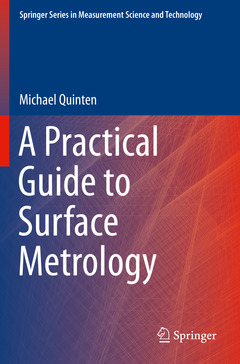A Practical Guide to Surface Metrology, 1st ed. 2019 Springer Series in Measurement Science and Technology Series

This book offers a genuinely practical introduction to the most commonly encountered optical and non-optical systems used for the metrology and characterization of surfaces, including guidance on best practice, calibration, advantages and disadvantages, and interpretation of results. It enables the user to select the best approach in a given context.
Most methods in surface metrology are based upon the interaction of light or electromagnetic radiation (UV, NIR, IR), and different optical effects are utilized to get a certain optical response from the surface; some of them record only the intensity reflected or scattered by the surface, others use interference of EM waves to obtain a characteristic response from the surface. The book covers techniques ranging from microscopy (including confocal, SNOM and digital holographic microscopy) through interferometry (including white light, multi-wavelength, grazing incidence and shearing) to spectral reflectometry and ellipsometry. The non-optical methods comprise tactile methods (stylus tip, AFM) as well as capacitive and inductive methods (capacitive sensors, eddy current sensors).The book provides:
- Overview of the working principles
- Description of advantages and disadvantages
- Currently achievable numbers for resolutions, repeatability, and reproducibility
- Examples of real-world applications
A final chapter discusses examples where the combination of different surface metrology techniques in a multi-sensor system can reasonably contribute to a better understanding of surface properties as well as a faster characterization of surfaces in industrial applications. The book is aimed at scientists and engineers who use such methods for the measurement and characterization of
surfaces across a wide range of fields and industries, including electronics, energy, automotive and medical engineering.
Offers advice on the advantages and disadvantages of various optical and non-optical metrology techniques in different situations
Describes best practice and gives genuine real-world examples and case studies
Includes achievable numbers for resolutions and reproducibility for each technique
Date de parution : 08-2021
Ouvrage de 230 p.
15.5x23.5 cm
Date de parution : 01-2020
Ouvrage de 230 p.
15.5x23.5 cm
Mots-clés :
Practical surface measurement; Practical surface characterisation; Surface optical metrology; Scanning nearfield optical microscopy; White light interferometry; Confocal optical profiling; Light sectional methods; Multi-wavelength interferometry; Grazing incidence interferometry; Shearing interferometry; Digital holographic microscopy; Elastic light scattering; Spectral Reflectometry and Ellipsometry



